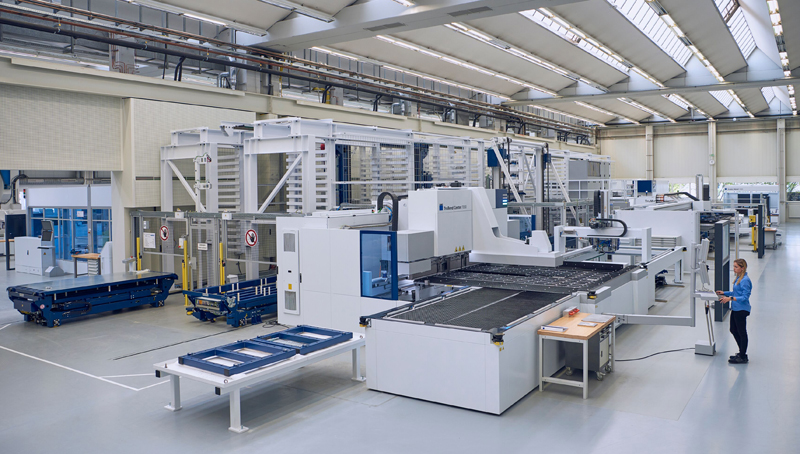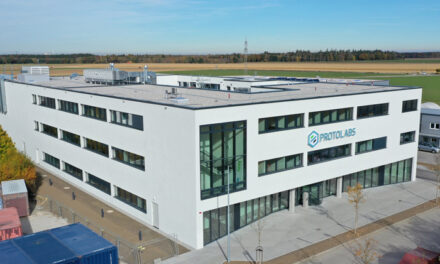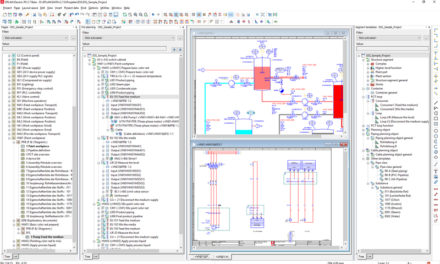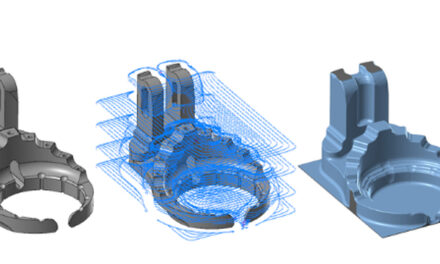Siemens solutions enable TRUMPF to improve quality while reducing time-to-market
Sheet metal processing and beyond
From handheld electronic devices and kitchen implements to automobiles, many products we use on a daily basis are comprised of parts made of cut and formed sheet metal. This is by no means limited to body or housing parts. Many industries use complex sheet metal parts as structural components. In many applications, this practice has long since replaced casting and machining as sheet metal parts are both lighter in weight and easier to produce in large quantities.
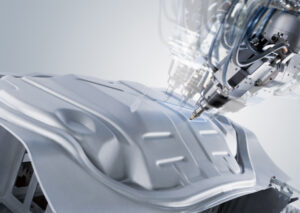 This is facilitated by specific machine tools for cutting sheet metal blanks and forming the parts. Among the pioneers and globally leading manufacturers of sheet metal processing equipment is the TRUMPF Group headquartered in Ditzingen near Stuttgart, Germany. Established in 1923, TRUMPF presented the world’s first sheet metal processing machine with numerical path control in 1968, enabling a fully automated work process including tool changes. As early as 1979, TRUMPF integrated laser technology in a combination punch laser machine.
This is facilitated by specific machine tools for cutting sheet metal blanks and forming the parts. Among the pioneers and globally leading manufacturers of sheet metal processing equipment is the TRUMPF Group headquartered in Ditzingen near Stuttgart, Germany. Established in 1923, TRUMPF presented the world’s first sheet metal processing machine with numerical path control in 1968, enabling a fully automated work process including tool changes. As early as 1979, TRUMPF integrated laser technology in a combination punch laser machine.
As the imported beam sources were lacking in precision and reliability, TRUMPF started manufacturing its own, becoming a laser manufacturer in 1985. This in-house competence boosted the development of highly competitive high-speed laser cutters such as the TruLaser 5030. It also allowed TRUMPF to diversify. Aside from laser systems for cutting, welding and surface treatment of 3D parts, the group offers high-performance lasers and generators as well as laser-driven additive manufacturing (AM) solutions.
TRUMPF’s largest area of activity is machine tools for flexible sheet metal and tube processing. The portfolio includes machines for bending, punching and combined punch and laser processing, as well as for laser cutting and laser welding applications. It is supplemented by tailor-made machine, automation and networking and software solutions to assist operators in all their machining tasks, converting 2D blanks to completed 3D product, from design to production control. In its smart factories in Germany and the United States, TRUMPF provides consultation and training to customers introducing digitally networked Industry 4.0 production solutions.
Growing importance of software testing
TRUMPF reinvests more than 10 percent of its annual revenues in research and development (R&D). A growing portion of this goes into software development. Extending functionality and continuously improving the control and visualization software not only benefit buyers of new machines, but biannual software releases facilitate extending, updating and upgrading existing TRUMPF sheet metal 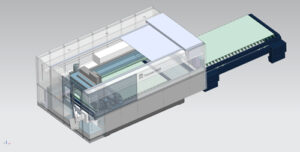 processing equipment.
processing equipment.
Although TRUMPF machines are standardized with an identical core at the heart of each product family, they come in a large variety and with numerous options. This poses a challenge when testing new software prior to its release. Although the software created for use in the machines’ programmable logic controllers (PLCs) comes with certain self-test routines, these do not represent the temporal behavior of the complex mechatronic equipment. In the past, final tests had to be performed using physical prototypes. TRUMPF kept machines of each type in a number of configurations to use as testbeds for software testing and troubleshooting.
– Using real machines, going through all of a machine’s functionalities during software tests was cumbersome and time-consuming, says Bernd Renz, head of TRUMPF’s machine dynamics department. It also meant not being able to try out all conceivable configuration options and error scenarios.
Using a digital twin for testing
To overcome these shortcomings, the TRUMPF machine dynamics department engineers decided to use a digital twin of each machine rather than the hardware for software testing. According to Renz, finding the right software for this complex set of tasks proved a challenge in its own right. Although many modeling software products are optimized for virtual commissioning of individual machines using hardware-in-the-loop (HiL) simulation, testing a number of computer models in the virtual world requires software-in-the-loop (SiL) simulation.
The TRUMPF engineers acquired intelligence on several software products, using three to model the company’s TruLaser 5030 laser cutting machine. Following competitive benchmarking, they chose a combination of products frequently used as a solution for virtual commissioning from the Xcelerator portfolio , the comprehensive and integrated portfolio of software and services from Siemens Digital Industries Software. It consists of Mechatronics Concept Designer software, which is part of the NX software portfolio for computeraided design, engineering and manufacturing (CAD/CAE/CAM), and the SIMIT simulation platform.
– Between them, these two simulation solutions allowed us to create what we call the virtual TRUMPF Machine, says Renz. It uses a model library to comfortably and semi-automatically create a digital twin for all the different machines required for each software test run.
Testing in a completely virtual environment
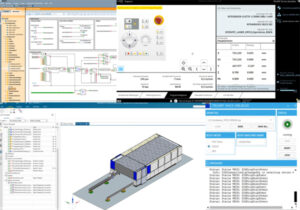 Using Mechatronics Concept Designer, the TRUMPF engineers created kinematic models of all components and assemblies that could be used in a TruLaser 5030 configuration. To do so, they imported the 3D models from the company’s CAD software and enriched the solids with information on the kinematic dependencies and physical properties relevant for inertia or gravitational effects.
Using Mechatronics Concept Designer, the TRUMPF engineers created kinematic models of all components and assemblies that could be used in a TruLaser 5030 configuration. To do so, they imported the 3D models from the company’s CAD software and enriched the solids with information on the kinematic dependencies and physical properties relevant for inertia or gravitational effects.
– With its user-friendly handling and powerful import functionalities, Mechatronics Concept Designer made it easy for us to lay the foundation for the digital twin to use as a testbed, Renz confirms. As it contains a full-fledged 3D modeling engine, it also facilitates on-the-fly changes such as model simplification for improved performance.
The SIMIT simulation platform facilitates easy coupling between the simulation and automation environment, either with HiL or SiL without using automation system hardware.
To create comprehensive functional models, the platform provides several libraries with industry-specific and simulation components. Using SIMIT templates, the TRUMPF engineers built a model library with all TruLaser 5030 components and their temporal behavior.
The virtual TRUMPF Machine
TRUMPF experts developed configuration software that uses the SIMIT model library to semi-automatically configure a number of individual machine models for automated testing. This digital twin configurator also sets the parameters for the shared memory interface to the simulation connector. This piece of software also developed in-house links and synchronizes the SIMIT behavioral model with the virtual numeric control kernel (VNCK) and orchestrates all software tools involved.
Between them, SIMIT and Mechatronics Concept Designer and the software tools developed in-house can support the use of parts and assemblies with different version statuses to compile a comprehensive digital twin of all possible configurations of the so-called virtual TRUMPF Machine (vTM). Over time, this will include all automatic handling implements the machine can be equipped with. – The digital twin of a standard machine would involve 80 percent SIMIT and only 20 percent Mechatronics Concept Designer models, says machine dynamics engineer Kevin Diebels, who was in charge of creating the overall software solution. If a machine is embedded in automated handling, this ratio is the other way around.
Overnight software testing
Investing in the automated testing solution that automatically generates a comprehensive digital twin of all required machine configurations is paying off in multiple ways. One is the greatly reduced time and expenditure it takes to build a new machine configuration for testing digitally rather than as a physical prototype once the model library contains all components of a particular type of machine. – We were able to model a similar machine within two days, says Diebels.
The reduced time required for the testing was even more spectacular: – While software release tests previously took four weeks, we now complete them overnight, Diebels adds. The automated test procedure using the digital twin created using Mechatronics Concept Designer and SIMIT covers more configuration options.
– Overnight software tests using the virtual TRUMPF Machine as a testbed enables us to substantially cut time-to-market for innovations while ensuring bug-free software, concludes Renz. We expect return-on-investment in under a year.

